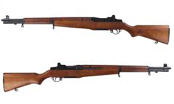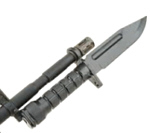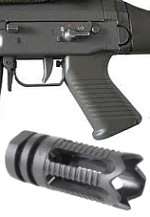

The "Assault Rifle" Conundrum
A letter to Hon. Ted Cruz
![]()
By David T. Hardy, Attorney at Law.
February 10, 2013
Hon. Ted Cruz, Ranking Minority Member Subcommittee on the Constitution,
Civil Rights and Human Rights
Senate Committee on the Judiciary
224 Dirksen Senate Office Building
Washington, DC 20510
Dear Sen. Cruz,
 I write in connection with the subcommittee's hearing on proposals to reduce gun violence. I will try to be concise.
I write in connection with the subcommittee's hearing on proposals to reduce gun violence. I will try to be concise.
Nature of the "Semiautomatic Assault Weapon" Concept "Assault rifle" is a rough translation of the German "sturmgewehr," or "storm-rifle." The concept underlying this class of firearms dates to World War II.
All the nations involved in that conflict entered it with semiautomatic or bolt action rifles firing cartridges that were remarkably similar, developing somewhat over 2,000 foot/pounds of energy, and designed to be effective out to 600-800 yards. These cartridges were too powerful for full automatic fire from a standard rifle: no soldier could stand the recoil at full automatic.
During the War, however, German engineers realized that infantry battles occurred at 200-300 yards; in most terrain it was hard even to see opposing infantry beyond that distance. If the military cartridge's power were cut by about half, from 2,000 foot/pounds to about 1,000, it could be fired at full automatic, and still suffice for conflicts at 200-300 yards. This gave rise to the first sturmgewehr, the MP 43/44, firing a smaller rifle cartridge at full automatic. Thus any true "assault rifle" is capable of full automatic fire; that is core to its purpose. A "semiautomatic assault rifle" is simply a semiautomatic rifle of about half the power of a standard WWII rifle.
 To give a concrete example: the United States fought WWII with the semiautomatic M-1 Garand; it fired a .30-06 cartridge with about 2,400 foot/pounds of energy. The modern AR-15 platform rifle fires a .223 caliber (5.56 mm) cartridge with about 1,250 foot/pounds of energy. To give another: the Soviets fought WWII with a 7.62 mm rifle, shooting a 147 grain bullet at 2,717 feet per second. The AK-47 fires a 123 grain bullet at 2,350 feet per second; its projectile is both lighter and slower than the WWII round. An "assault rifle" is by definition full automatic (also known as select fire). A semiautomatic version is simply a semiautomatic rifle of less power than WWII semiautomatic rifles.
To give a concrete example: the United States fought WWII with the semiautomatic M-1 Garand; it fired a .30-06 cartridge with about 2,400 foot/pounds of energy. The modern AR-15 platform rifle fires a .223 caliber (5.56 mm) cartridge with about 1,250 foot/pounds of energy. To give another: the Soviets fought WWII with a 7.62 mm rifle, shooting a 147 grain bullet at 2,717 feet per second. The AK-47 fires a 123 grain bullet at 2,350 feet per second; its projectile is both lighter and slower than the WWII round. An "assault rifle" is by definition full automatic (also known as select fire). A semiautomatic version is simply a semiautomatic rifle of less power than WWII semiautomatic rifles.
So what is the origin of the idea that there is such a thing as a"semiautomatic assault rifle," and that it is somewhere especially dangerous? Backin the 1990s, the Violence Policy Center, an antigun group, issued a report that proposed making such rifles a focus, because in the popular mind they were easily confused with fully automatic firearms. It essentially proposed a public relations campaign based on deception. An attack on recognized constitutional rights, based upon deception and taking advantage of mistaken popular impressions, seems questionable to anyone who holds a commitment to the Constitution. Let us go into more detail.
The Scope of the Second Amendment: "Firearms in General Use"
Heller v. District of Columbia noted that "Miller said, as we have explained, that the sorts of weapons protected were those in common use at the time." 128S.Ct. at 2817. The AR-15 platform has become the epitome of a firearm "in common use." I refer to it as a platform, since the AR-15 is "modular"; its receiver has two parts: an upper receiver into which the barrel mounts, and a lower receiver, which holds the firing assembly, and mounts the buttstock and lower grip. The two can be disconnected in about a minute.
 By mounting another upper receiver and barrel, an AR-15 can be enabled to fire a wide range of rifle and handgun cartridges, and the length and weight of the barrel can be changed to suit the owner's needs. A single rifle can thus suffice for target matches, law enforcement, and hunting small and large game. While other firearms can be re-barreled to a new caliber or cartridge, this is generally work that can only be done by a gunsmith with specialized tools.
By mounting another upper receiver and barrel, an AR-15 can be enabled to fire a wide range of rifle and handgun cartridges, and the length and weight of the barrel can be changed to suit the owner's needs. A single rifle can thus suffice for target matches, law enforcement, and hunting small and large game. While other firearms can be re-barreled to a new caliber or cartridge, this is generally work that can only be done by a gunsmith with specialized tools.
An AR-15 owner might switch between .223 or .22-250 for small game and target competition, 6.8 mm for deer hunting, and .50 Beowulf for home protection or larger game such as bears.The AR-15 is probably the semiautomatic rifle in most common use by Americans today.
Assessing this is not a simple task, because rifle manufacturers are required to report to the government only the total number of rifles made, not broken down by design. I base this conclusion on the following:
1. A friend and fellow researcher, Mark Overstreet, has compiled a breakdown of rifle manufacturers who produce only AR-15 type rifles. In 2008, the most recent year for which data was available, these manufacturers produced 22% of American civilian rifle production. (The fact that this portion of firearms manufacturing can be profitable producing nothing but AR-15s speaks for itself).
2. In addition to these, there are many manufacturers who make AR-15s together with other firearms, and this number is rising. For example, the handgun manufacturer Smith and Wesson recently brought out two rifles, both of them AR-15 types. Remington, which mainly produces bolt-action rifles, has brought out an AR-15. Ruger Arms, which manufactured the AR- 15's main competition, the Ruger Mini-14, has now brought out its own AR-15.
3. In 2010, the National Shooting Sports Foundation surveyed over 8,000 shooters. The results indicated that about 8.9 million Americans went target shooting with AR-15 type rifles in the previous year.
 4. A 2012 survey by the National Shooting Sports Foundation found that 26.3% of shooters owned an AR-15-type firearm, up from 18.1% the previous year. In addition, 21% of shooters who did not already own one planned to acquire one in the next year. Based on these data, it is clear that the AR-15 platform qualifies as "in common use." The same would be true of the AR-15's standard magazines, which hold 20 or 30 rounds. The number of these in use (many of them sold as surplus by the government itself) is likely in the tens of millions.
4. A 2012 survey by the National Shooting Sports Foundation found that 26.3% of shooters owned an AR-15-type firearm, up from 18.1% the previous year. In addition, 21% of shooters who did not already own one planned to acquire one in the next year. Based on these data, it is clear that the AR-15 platform qualifies as "in common use." The same would be true of the AR-15's standard magazines, which hold 20 or 30 rounds. The number of these in use (many of them sold as surplus by the government itself) is likely in the tens of millions.
Permissible Restrictions
Of course, constitutionally-protected activity is subject to some restrictions. The Heller decision indicates that these must pass some level of heightened scrutiny -- either strict scrutiny or intermediate review -- which alike require proof of some relationship to genuinely achieving and important goal, while minimizing unnecessary impact on the protected activities. I see two considerations here, relating to the persons affected and to the arms regulated.
1: http://www.nssf.org/NewsRoom/releases/show.cfm?PR=041910.cfm&path=2010.
2: http://www.nssf.org/PDF/research/0412SurveyTrackerSupplement_MSR.pdf.
Persons Affected
Police and "civilians" own firearms for the same reason: self-defense against criminal activity. It is difficult to justify any legislation that would bind one but not the other, when both have the same purpose and need. That is to say, if law enforcement officials need an AR-15, or a 20 round magazine to defend themselves, it is hard to explain why a non-LEO would not.
Even less explicable are laws which exempt not only serving LEOs, but also retired ones. Retirement includes disability retirement, which includes disability due to mental status.
Scope of Regulation
As noted above, "semiautomatic assault rifle" is internally contradictory and thus meaningless. A "semiautomatic assault rifle" is simply a semiautomatic rifle of about half military power. Drafters of legislation are thus forced to define what they would restrict in ways that are arbitrary and irrational. One approach is to ban rifles by name; this is exceptionally arbitrary, since it can ban one firearm while allowing others with exactly the same capabilities to be made.
For example, the 1994 ban applied to the "Colt AR-15" but not to the Ruger Mini-14, even though both fired the same cartridge at the same rate of fire from magazines of the same size.
 The other approach is to ban rifles with certain features, cosmetic in nature, affecting appearance but not function. To take some examples, from the 1994 ban:
The other approach is to ban rifles with certain features, cosmetic in nature, affecting appearance but not function. To take some examples, from the 1994 ban:
Bayonet lugs. Enough said. I have never in my life seen a report of a criminal bayoneting someone. Banning this feature is utterly irrational. Grenade launchers. Any real, functional, rifle grenade is so tightly regulated as to be impossible to obtain. A launcher for one is a matter of appearance, not of function.
 "Pistol grips." I put this in quotations since all modern rifles have a pistol grip. What is meant is a pistol grip separate from the buttstock, the portion of the stock that leads back to the shoulder. The separate pistol grip is a byproduct of designs that raise the buttstock, in order to reduce "muzzle flip."
"Pistol grips." I put this in quotations since all modern rifles have a pistol grip. What is meant is a pistol grip separate from the buttstock, the portion of the stock that leads back to the shoulder. The separate pistol grip is a byproduct of designs that raise the buttstock, in order to reduce "muzzle flip."
Flash suppressors. The flash suppressor is a small structure at the end of the barrel, designed to minimize the firearm's flash at night. With modern ammunition, fired at semi-automatic rates, it is nearly impossible to see the flash, even without such a suppressor. I have verified this by firing an AR-15 with and without the suppressor in a completely dark rifle range. Again, this is not something that has any effect on function.
When a rifle fires, the recoil come back along the line of the barrel. Traditionally, the line of the barrel would pass above the center of the shooter's shoulder. This caused the rifle to flip up in recoil. This was undesirable in full automatic fire, since only the first shot would go where it was aimed, the following shots would go high.
The solution was to move the shoulder stock higher, closer to the line of the barrel, thus making the recoil push the shooter straight back, without the barrel flipping upward. But if the pistol grip remained integral with the buttstock, the hand holding the grip would be twisted into an unnatural position. The solution was to make the pistol grip separate from the buttstock. This result was an artifact of the decision to raise the buttstock. With semiautomatic rifles, the problem of the rifle climbing during firing a burst does not exist. The separate pistol grip is a matter of design, not of function.
Sincerely,
David T. Hardy
![]()




































